Understanding Common Terminology for Rhinoplasty
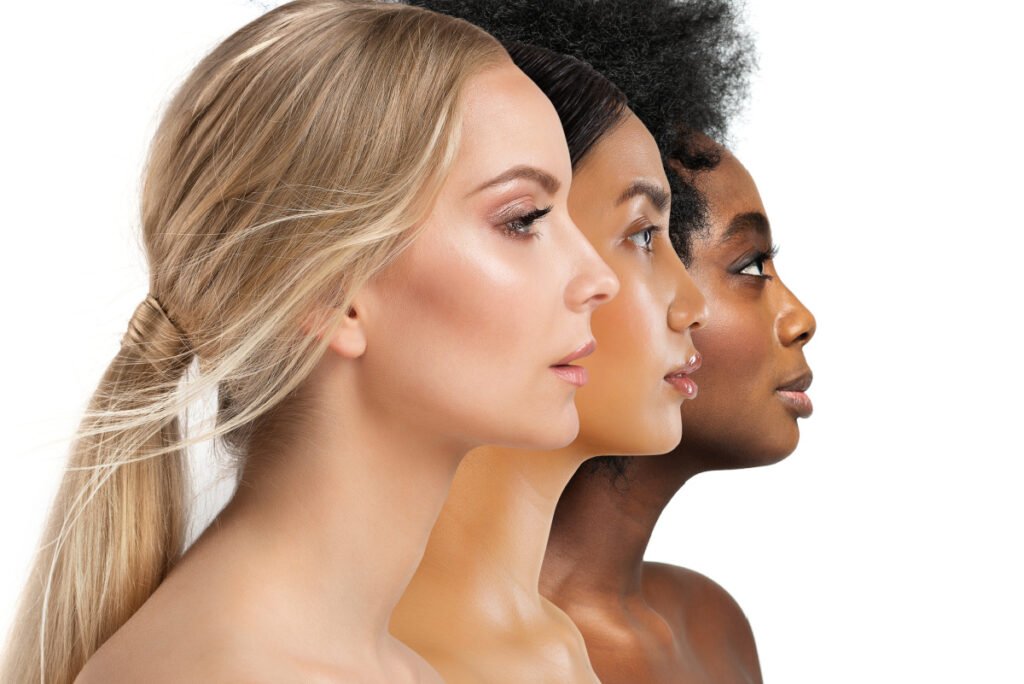
Rhinoplasty, or “nose job,” refers to aesthetic surgery of the nose. While commonly performed, it is a relatively complex operation; as a result, you will see a lot of specialized terminology while researching options. Understanding these terms can make it easier for you to communicate with your facial cosmetic surgeon and better understand how they can optimize your appearance while preserving (or improving) nasal functions.
To help, board-certified otolaryngologist, facial cosmetic surgeon, and ABFCS diplomate Dr. Scott McCusker recently sat down to explain modern rhinoplasty terminology, using his own illustrations and photos of his actual patients (shared with their express written permission).
This article is intended to serve as a broad overview to promote patient education rather than a promotion of any specific approach; your surgeon’s individual treatment recommendations will vary based on your concerns and anatomy.
Nasal Anatomy
The anatomy of the nose is surprisingly complex, and gives the nose its distinctive shape. Please note that you will often see slightly different descriptions of these terms, or conflicting usage. For simplicity, we are not going to discuss every structure, only the most important.
Surface landmarks
Please refer to the diagram for the locations of the following surface landmarks: radix (nasion), rhinion, supratip area, tip complex, infratip lobule, columella, and nasal base. The nostrils are referred to as the nasal ala (plural alae), or the nares.

The next diagram shows the deeper structures including nasal bones, upper lateral cartilages, lower lateral cartilages, and nasal septum (consisting of the quadrangular cartilage anteriorly and the bony septum posteriorly).

The deeper structures include the nasal bones, upper lateral cartilages, lower lateral cartilages, and nasal septum. On the CT scans, note the turbinates, which have an important role in nasal breathing, as well as the relation to the sinuses, eyes, and brain.


Closed vs Open Rhinoplasty
When performed by a board-certified facial cosmetic surgeon, both techniques offer excellent long term results, and the decision of which technique is best is largely based on the surgeon’s training and expertise as well as the patient’s unique anatomy and aesthetic and functional goals.


Closed rhinoplasty
Closed rhinoplasty is conducted using only incisions inside the nose. Closed rhinoplasty has the advantage of avoiding the external scar and less swelling in the immediate postoperative period, but many rhinoplasty maneuvers are more difficult or impossible with closed techniques.
Open rhinoplasty
In contrast, open rhinoplasty utilizes a small incision on the bottom of the nose, referred to as a “transcolumellar incision.” Open rhinoplasty allows for a much broader exposure of the entire structure of the nose, facilitating the use of complex cartilage grafting and manipulation techniques, but at the expense of more swelling in the postop period and a small external scar. While the swelling lasts for months, the thin scar will eventually fade enough to be undetectable for most patients, becoming essentially invisible once fully healed.
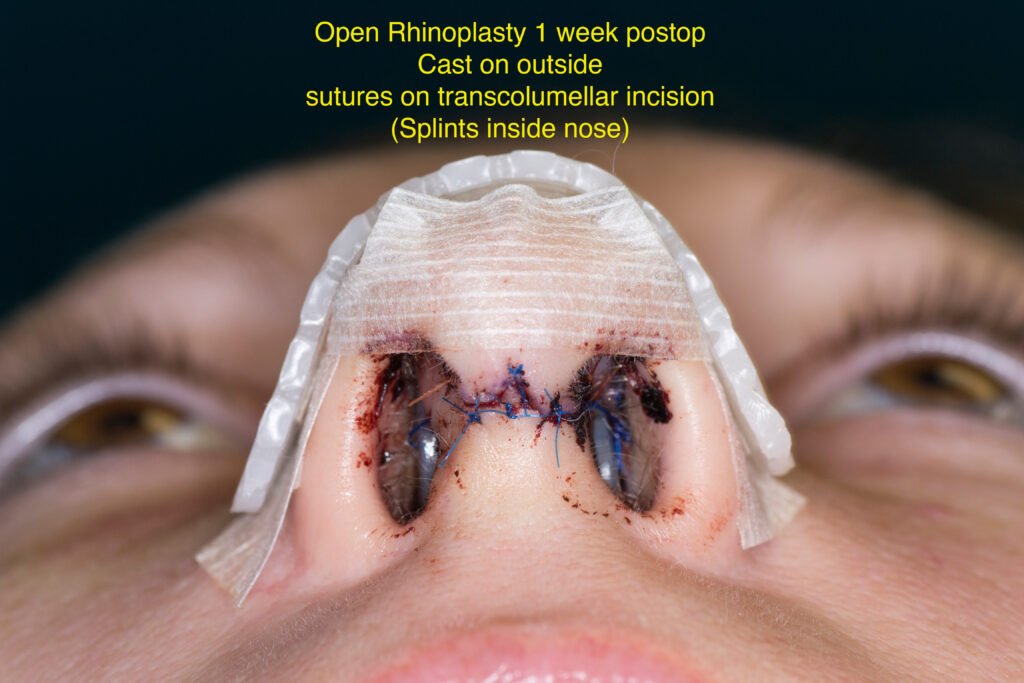

Primary vs Revision Surgery
Primary rhinoplasty refers to the first time surgery is performed, whereas revision surgery refers to any subsequent operations. In almost all situations, the goal is for the patient to have one surgery with excellent results, but between 5%-15% of patients who undergo rhinoplasty will end up having revision surgery for various reasons—most commonly due to poor cosmetic outcome or difficulty breathing through the nose. With meticulous surgical technique, the rate of revisions can be lowered significantly, but not eliminated.
“Preservation” vs “Structure” Rhinoplasty
Historically, rhinoplasty was almost all “reductive” in nature, that is, removing bone and cartilage to shrink the nose. Unfortunately, this led to many people developing breathing problems, as the important support structures that maintain the nasal airway were compromised in the process.
Structure rhinoplasty
In response to this, the “structure” approach was developed, which aims to replace and rebuild the cartilage structure, reshaping it to be more aesthetically pleasing in the process. This approach is in widespread use now, with hundreds of published variations that make it applicable to almost any nasal shape or problem type. It is a technically challenging operation, and dependent on the use of several cartilage grafts as well as delicate suture techniques, and, with few exceptions, requires an open approach.
Preservation rhinoplasty
Over the past several years, there has been increased attention paid to a different approach called “preservation” rhinoplasty. This approach calls for avoiding any removal of the top of the nasal bones and nasal cartilages (hence preservation), and instead removing a wedge of bone from the side of the nasal bone where it attaches to the cheek, then pushing the nasal complex down to correct the bump (dorsal hump). **authors note, I’ll draw some pictures to illustrate these techniques** While cartilage grafting can be performed in conjunction with preservation rhinoplasty, it is less commonly required. Preservation rhinoplasty can be performed via closed or open techniques, and is a rapidly evolving field. As such, it is becoming more widely applicable to a range of nasal problems.
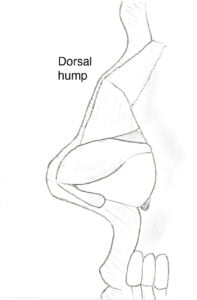
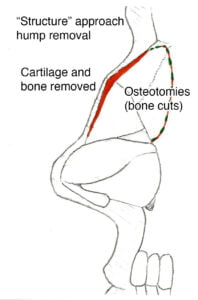

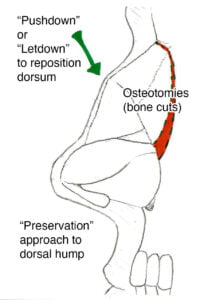

At present, neither technique is obviously superior or inferior—both can give excellent, long-lasting results. The choice of approach is largely dependent on the surgeon’s training and experience.
Functional Nasal Surgery
As alluded to above, nasal surgery can be used to both reshape the nose and to improve nasal breathing. Many patients may have purely functional or aesthetic concerns, but a large number of patients have a mix of both. In general, there are three main surgical targets for correcting mechanical obstruction of the nose:
- Nasal septum (“deviated septum”)
- Nasal turbinates (“turbinoplasty”)
- Nasal valve or the soft part of the nose (“nasal valve stenosis repair”)
Most patients with symptomatic nasal obstruction have some degree of contribution from each of these three elements, but the amount from each is highly variable. In many patients, the obstruction is a result of previous trauma or surgery, but it is also common to have congenital or developmental factors at play. Both closed or open approaches can be used, depending on the nature of the problem, and concurrent aesthetic maneuvers (i.e. cosmetic reshaping) can be performed. Balancing functional and aesthetic concerns can be incredibly challenging, but with modern techniques and an experienced rhinoplasty surgeon, most patients can achieve excellent results in all areas.
Common Aesthetic Concerns
While there are countless variations of the shape of the nose, there are several common aesthetic concerns. Knowing how to describe these is very important in communicating what bothers you about your nose and how you would like it to change. It is also worth stating that there is no one ideal aesthetic for the shape of the nose—it has to fit the rest of the face, and there is a wide variation of what is considered beautiful in the nose.
Dorsal hump
A “dorsal hump” is a bump in the middle 1/3 of the nose, generally most noticeable from the side. People will often refer to this as a “Roman nose,” or say their nose is “crooked,” or simply that their nose has a bump. Creating a straighter dorsal line is a very common aesthetic goal.

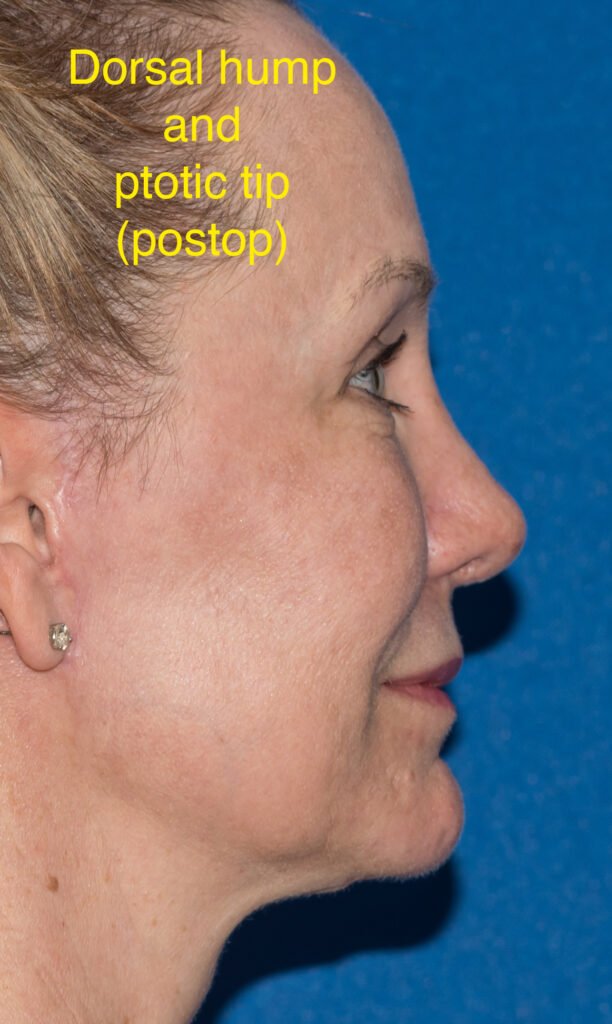
Asymmetry
Side-to-side asymmetry of the nose seen from the front is referred to by various terms, depending on the way in which it is asymmetric—most commonly a “twisted” or “c-shaped” deformity with the upper and lower thirds of the nose pointing in different directions, as seen in the accompanying picture. In contrast, a “deviated” nose has all of the nose pointing in the same direction.


Nasal tip shape
The shape of the nasal tip is one of the most common concerns, and the tip has a very complicated geometry. Appropriately balancing this geometry is key to a good-looking result.


Oversized nose
One of the most common patient complaints is that they have a “big nose.” It is important to separate and define this problem more thoroughly: Is the entire nose large, and sticking out from the face (“overprojected”)? Is it just the tip that is overprojected? Is the tip rotated upward (“cephalic rotation” or “over rotation”), or is it drooping (“ptotic tip”)? Is the tip “refined” and delicate looking or is it “amorphous?” Is the tip “angular” or is it “bulbous?.” A related variable is the thickness of the skin on the nose. While this skin is generally some of the thinnest skin in the body, there is considerable variation in skin thickness and texture, which will affect the shape of the tip greatly. Thin skin leads to a much more angular appearance, whereas thick skin gives a rounder nose.


Nostril / nasal base size
The size of the nostrils, as well as the width of the nasal base is another common concern, and reducing the size of the nostrils and or width of the base is frequently requested. This is commonly referred to as a “Weir incision,” although most surgeons use a modification or refinement of this technique today.



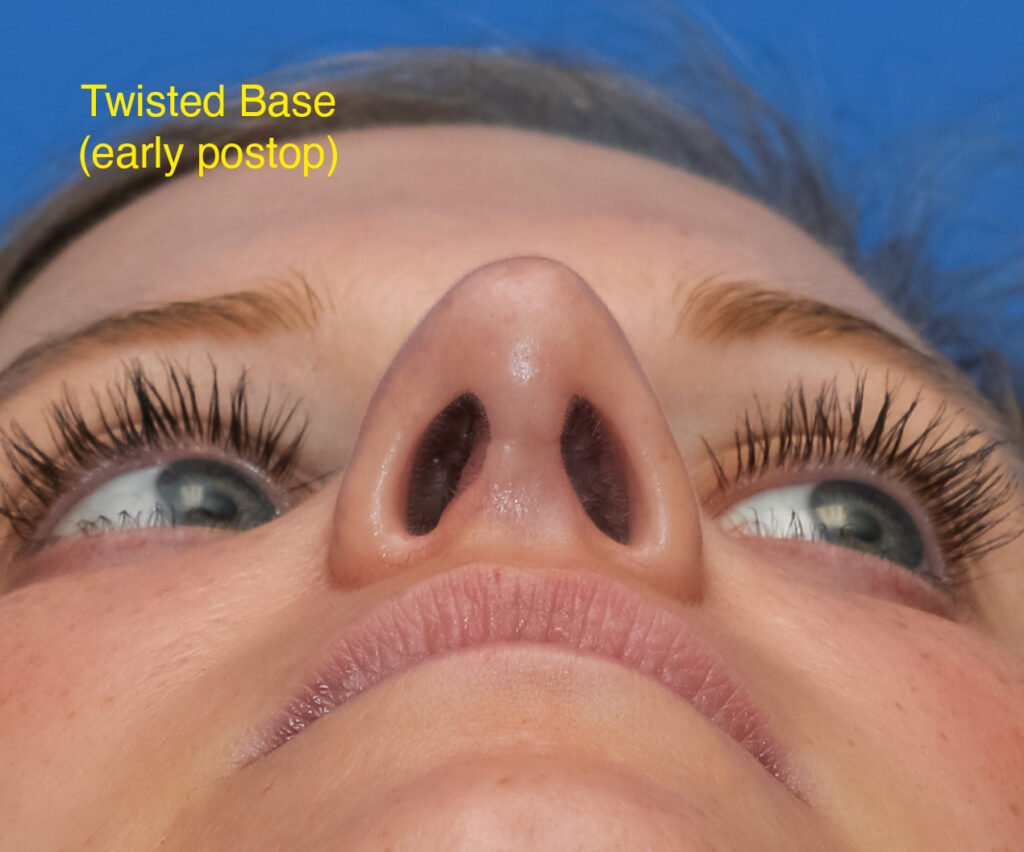
In sum, rhinoplasty is a complicated surgery—or more correctly described, a family of surgeries. The jargon surrounding it is equally complicated, and having some understanding of this terminology can help empower you to communicate with your surgeon about what your specific concerns are, and understand how your surgeon intends to achieve them.
Choose a surgeon certified by the American Board of Facial Cosmetic Surgery for Rhinoplasty
When choosing a cosmetic surgeon to improve the appearance of your nose and preserve its natural functions, trust a highly-qualified aesthetic specialist. Facial cosmetic surgeons certified by the American Board of Facial Cosmetic Surgery (ABFCS) undergo rigorous testing to prove their expertise in treating cosmetic concerns that affect the face, head, and neck. ABFCS surgeons stay abreast of the safest, most advanced techniques for optimizing your facial appearance. To find an ABFCS-certified surgeon near you, use our Find a Surgeon tool.